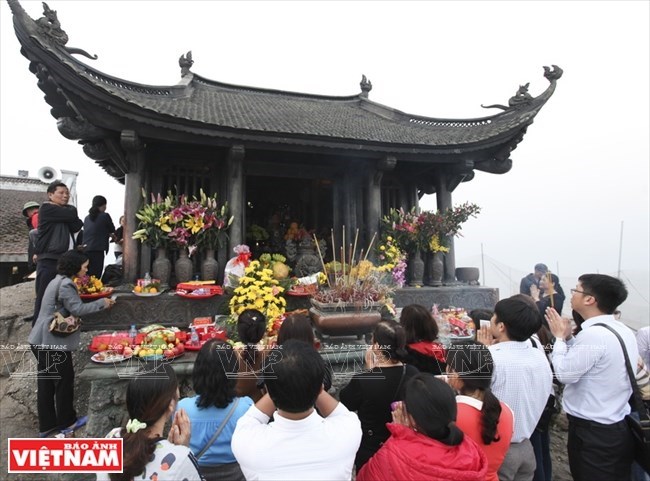


Dong pagoda
located on the peak of Yen Tu mountains (Source: VNA)
Key events held within the festival include the opening ceremony, Cherry
Blossom and Yen Tu yellow apricot blossom festival and Hang Son Pagoda Festival.
This year, Uong Bi city will work to ensure social order and traffic safety and
prevent fire and explosion. Kiosks will be arranged to introduce tourism
products and services to visitors.
In preparation for the festival, investments have been made in infrastructure
in the Yen Tu spiritual tourism site, including the upgrade of the road to Yen
Tu relic site and the construction of a new cable car system to prevent traffic
congestion.
The province is also working to complete the first phase of the Yen Tu festival
tourism services centre, which features Truc Lam palace, a Zen village, a
pilgrimage village and the King monk Tran Nhan Tong museum.
Last year, Yen Tu relic site attracted more than 2 million visitors, including
250,000 foreigners, up 200 percent against 2016’s figure.
Yen Tu Mountain is located about 50 kilometres from Ha Long City. The area has
awe-inspiring scenery, surrounded by ancient pagodas and hermitages.
Tran Nhan Tong (1258-1308), the third King of the Tran dynasty, ascended to the
throne when he was just 21. He is famed for defeating Mongol invaders twice
during his 15-year reign.
The King abdicated when he was 35 and spent the rest of his life on Yen Tu
Mountain practicing and propagating Buddhism. He founded the first Vietnamese School
of Buddhism called "Thien Tong” or Truc Lam Yen Tu Zen on the 1,068m-high Yen
Tu Mountain. The 20,000ha site is considered the capital of Vietnamese
Buddhism.
Yen Tu became a major Buddhist Centre and King Tran Nhan Tong became its first
leader under the religious name Dieu Ngu Giac Hoang Tran Nhan Tong. He ordered
the construction of hundreds of religious buildings on Yen Tu Mountains for
teaching and following a religious life.
Besides numerous temples, it also preserves many old religious and cultural
documents such as precious prayer-books and monks’ writings.
Yen Tu was officially listed as a special national relic site in September
2012.
Source: VNA